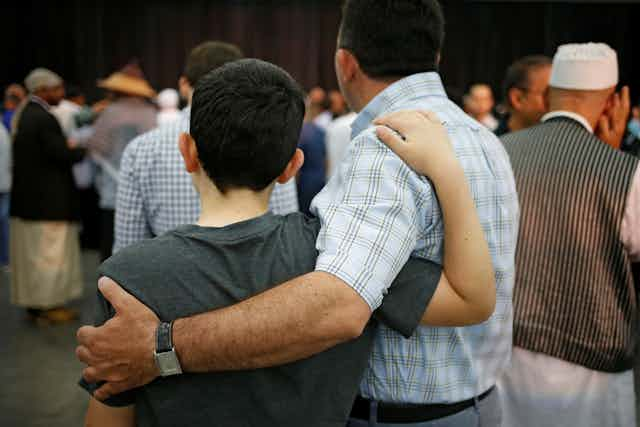On June 10 Americans celebrated Muhammad Ali as a paragon of athletic prowess, dignity in the face of suffering and patriotic dissent.
But his fellow American Muslims more commonly find themselves cast as a “problem” for American religious pluralism and a threat to American security. They join a long list of religious groups who have faced discrimination and public suspicion on account of their faith. Catholics, Jews, Mormons and many other communities have, at one time or other, been labeled as dangerous outsiders.
In response to this scrutiny and to affirm Islam as an American religion, some American Muslims are turning to emerging institutions that, because they are neither home nor mosque, are known as “third spaces.”
These communities include support groups for converts, virtual communities on social media and blogs, communities centered on devotional practices, book clubs, artist and writers’ collectives, and study circles. Third spaces vary in size. Some have been in place for decades, while others last for a short time. During my fieldwork, I encountered at least 30 such spaces in the Chicago area alone.
My forthcoming book, based on four years of ethnography in one such third space, shows how these institutions provide an essential look into the myriad of local expressions of American Islam.
Islam may often be presented as an unchanging monolith. But the American Muslim community exemplifies the racial, theological, geographical, political and religious diversity of the American society writ large.
Beyond the mosque
Why have these third spaces not received much public attention?
One answer is that too often, we look to mosques as representative of American Muslims generally. There is good reason to do so. Mosques are among the most important and common American Muslim institutions, with over 2,000 in the U.S.
The Arabic term for mosque, masjid, means the “place of prostration,” and refers to the bodily postures of the five daily prayers (salat).
Although salat may be performed anywhere, Muslims around the world gather at mosques on Friday afternoons for communal prayers and to listen to a sermon. In the U.S., mosques also serve as schools and community centers. They provide social services and host weddings and funerals.
However, mosques provide a limited perspective into the vibrant dynamics of American Muslim religious and social life.
Just as church attendance cannot adequately capture the dynamic religiosity of contemporary American Christians, so too the assumption that mosques represent American Muslims yields an incomplete picture.
According to the 2011 Pew report Muslim Americans: No Signs of Growth in Alienation of Support for Extremism, about 47 percent of American Muslims attend mosques weekly; 34 percent visit on a monthly or yearly basis and 19 percent are “unmosqued,” or never attend mosques. These figures approximate Christian church attendance.
Like other American practitioners, Muslims in the U.S. maintain various levels of observance and practice their faith in myriad ways.
Creative piety in third spaces
Another reason third spaces garner less consideration is that they tend to be local. Third spaces take advantage of their emergent and flexible character to build communities that more closely align with the theologies and social tastes of their members.
For example, the primary case study of my book, the Mohammed Alexander Russell Webb Foundation, is a family-centered institution located in the western Chicago suburbs.
Started in 2004, the foundation appeals to families with spouses of different ethnic and racial backgrounds, including first- and second-generation Arab and South Asian immigrants, African-Americans, as well as white and Latino converts, all of whom have struggled to find a religious community that accommodates this familial diversity.
About 150 students, both adult and children, attend Webb’s weekly Sunday school. Like many third spaces, Webb has no permanent building. Its activities take place in a variety of settings, including schools, hotels, parks and local community centers.
The Webb Foundation hosts activities such as football games, nature walks and ski trips to promote an “indigenous” American Islam. These practices work together with other rituals such as the mawlid, a celebration honoring the Prophet Muhammad, as well as conversations around the Qur’an and discussions of common parental concerns like saving for college.
Community service, such as supporting one of the city’s largest Thanksgiving turkey drives, illustrates members’ commitment to helping less fortunate, predominantly non-Muslim neighbors.
Taken together, the Webb Foundation produces an American Islam that promotes religious pluralism, opens up leadership roles for women – who are equally represented on the foundation’s board – celebrates the “best of American culture” and imagines the U.S. as the ideal site for practicing Islam.
Past, present and future of American Islam
Third spaces such as the Webb Foundation counter the common assumption that Islam is a “foreign” or “Arab” religion.
Proud of their American heritage, its members honor the long tradition of American Muslims who have served the United States through military, public and community service.
Born in Hudson, New York, in 1846 and raised a Presbyterian, Mohammed Alexander Russell Webb converted to Islam in the 1880s while serving as consul to the Philippines under President Grover Cleveland. He subsequently became the spokesperson for Islam at the 1893 World’s Parliament of Religions at the World’s Fair in Chicago. There he promoted his religion as the most universal and rational faith, challenging the fair’s exhibits that portrayed Muslims as exotic and romantic yet ultimately inferior to Protestant Christians.
A large majority of American Muslims are U.S. citizens. Some of the third spaces they are creating provide various opportunities – through rituals, outreach and service initiatives – for participants to explore more fully what it means to be an American Muslim, to fulfill religious obligations and in the process to challenge overwhelmingly negative representations of Islam and Muslims.
In this climate of fear and xenophobia, it is easy to fall back on ahistorical generalizations. We would do well to remember that no single institution represents all American Muslims, much less Islam.

